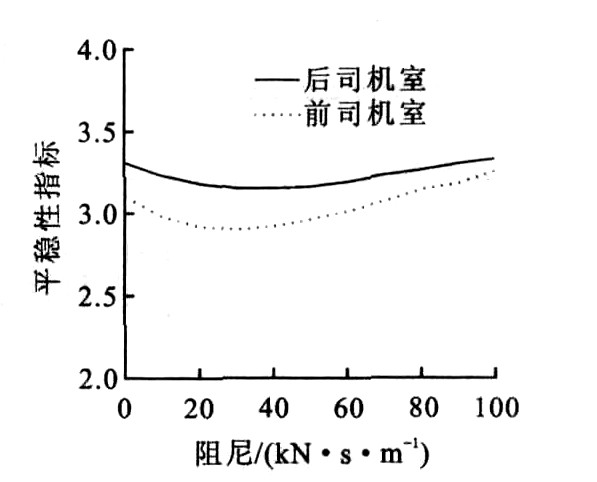Influence of lateral damper on locomotive riding quality
-
摘要: 基于机车车辆-轨道耦合动力学理论, 运用TTISIM (Train/Track Interaction Simulation) 仿真软件, 以横向减振器为研究对象, 以机车运行平稳性指标为依据, 系统分析了机车横向减振器的阻尼参数、工作状态、卸荷速度和悬挂位置等参数对于机车平稳性能的影响。仿真计算与分析结果表明: 选取适当横向减振器的结构阻尼参数, 对提高机车的平稳性有利; 采取适当的减振器卸荷速度可以达到提高乘车舒适性的目的; 横向减振器是否正常工作对机车的运行品质有较大影响, 必须严格确保所有减振器的正常工作; 横向减振器的悬挂位置, 对于车体的运行平稳性几乎没有影响。Abstract: Based on vehicle-track coupling dynamics, with simulation software TTISIM, the effects of the parameters, working condition, unloading velocity and position of lateral damper on the running performance of speed-raised locomotive were systematically investigated.Analysis result shows that it can improve locomotive riding performance to choose proper damping parameters and unloading velocity, the working condition of lateral damper has great effect on locomotive riding quality, so it must be ensured that all of dampers are in normal working states when locomotive runs on railway, its running performance is not sensitive to damper position.
-
Key words:
- vehicle engineering /
- lateral damper /
- sperling index /
- damping parameters /
- working condition /
- unloading velocity /
- damper position
-
表 1 平稳性指标
Table 1. Sperling indices
位置 阻尼/ (kN·s·m-1) 0 10 20 30 40 50 60 70 80 90 100 后司机室 3.31 3.23 3.18 3.15 3.15 3.16 3.19 3.23 3.26 3.30 3.33 前司机室 3.10 2.98 2.92 2.90 2.92 2.96 3.01 3.07 3.14 3.18 3.25 表 2 平稳性指标
Table 2. Sperling indices
位置 工作状态 均正常 后转向架左侧1个失效 后转向架2个失效 后转向架2个与前右侧1个失效 前转向架左侧1个失效 前转向架2个失效 前转向架2个与后右侧1个失效 全失效 后司机室 3.15 3.24 3.44 3.37 3.10 3.10 3.13 3.31 前司机室 2.92 2.88 2.91 2.93 2.97 3.16 3.10 3.10 表 3 指标计算结果
Table 3. Computation result of indices
工作状态 指标 车体横向加速度/ (m·s-2) 前司机室横向平稳性指标 脱轨系数 轮轴横向力/kN 4个均正常 2.1 2.99 0.65 63.72 2个失效(均为左侧) 2.4 3.06 0.86 74.01 4个均失效 2.5 3.25 0.86 76.75 表 4 平稳性指标
Table 4. Sperling indices
位置 卸荷速度/ (m·s-1) 0.01 0.05 0.10 0.15 0.20 0.30 0.40 0.50 后司机室 3.26 3.17 3.15 3.17 3.20 3.21 3.21 3.21 前司机室 3.03 2.90 2.92 2.93 2.95 2.96 2.96 2.96 表 5 平稳性指标
Table 5. Sperling indices
位置 L/m 0 0.5 1.0 1.5 2.0 后司机室 3.15 3.15 3.14 3.13 3.12 前司机室 2.92 2.92 2.92 2.92 2.92 -
[1] 翟婉明. 车辆-轨道耦合动力学[M]. 北京: 中国铁道出版社, 2002. [2] 王开云, 丁国富, 翟婉明. 机车车辆-轨道空间耦合动力学性能仿真系统[J]. 系统仿真学报, 2004, 16 (6): 2 737-2 740. https://www.cnki.com.cn/Article/CJFDTOTAL-XTFZ200412030.htmWang Kai-yun, Ding Guo-fu, Zhai Wan-ming. Simulation system of vehicle-track spatial coupling dynamics[J]. Journal of System Simulation, 2004, 16 (6): 2 737-2 740. (in Chinese) https://www.cnki.com.cn/Article/CJFDTOTAL-XTFZ200412030.htm [3] 王开云, 翟婉明, 刘建新, 等. 山区铁路小半径曲线强化轨道动力性能[J]. 交通运输工程学报, 2005, 5 (4): 15-19. http://transport.chd.edu.cn/article/id/200504004Wang Kai-yun, Zhai Wan-ming, Liu Jian-xin, et al. Dynamic performances of small-radius curved track for mountain strengthened railway[J]. Journal of Traffic and Transportation Engineering, 2005, 5 (4): 15-19. (in Chinese) http://transport.chd.edu.cn/article/id/200504004 [4] TB/T2360-93, 铁道机车动力学性能试验鉴定方法及评定标准[S]. [5] GB 5599-85, 铁道车辆动力学性能评定和试验鉴定规范[S]. -





 下载:
下载:









